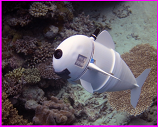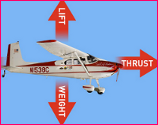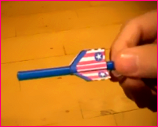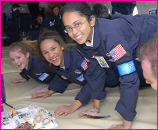Posted on August 31st, 2019 by Mary Lord
 Middle school students take on the role of marine biologists to investigate how sharks move in three-dimensional space (3-D). Understanding the mathematics behind shark movement will inform the design of a prototype joystick for a robotic exploration shark used to collect oceanic data.
Middle school students take on the role of marine biologists to investigate how sharks move in three-dimensional space (3-D). Understanding the mathematics behind shark movement will inform the design of a prototype joystick for a robotic exploration shark used to collect oceanic data.
Read More
Filed under: Class Activities, Grades 6-8, Lesson Plans | Comments Off on Move Like a Shark
Tags: 3-D motion, Aeronautics, Cartesian coordinates, Class Activities, drag, forces, Grades 6-8, Lesson Plan, programming, shark movement, speed, x, y, z axes
Posted on February 21st, 2016 by Mary Lord
 Students in grades 5 to 7 use Bernoulli’s principle to manipulate air pressure in a series of fun activities so its influence can be seen on the objects around us.
Students in grades 5 to 7 use Bernoulli’s principle to manipulate air pressure in a series of fun activities so its influence can be seen on the objects around us.
Read More
Filed under: Class Activities, Grades 6-8, Grades 6-8, Grades K-5, Grades K-5, Lesson Plans | Comments Off on Fun With Bernoulli
Tags: Aerodynamics, Aeronautics, Automotive engineering, Bernoulli's principle, Class Activities, forces and motion, Grades 6-8, Grades K-5, Lesson Plans, Mathematics, Physics
Posted on September 19th, 2012 by Mary Lord
 Why do airplanes fly? What is genetic engineering? To help K-12 students and teachers understand such topics, MIT has tapped its 10,000 brilliant young scholars to create engaging, short videos to supplement classroom instruction.
Why do airplanes fly? What is genetic engineering? To help K-12 students and teachers understand such topics, MIT has tapped its 10,000 brilliant young scholars to create engaging, short videos to supplement classroom instruction.
Read More
Filed under: K-12 Outreach Programs, Web Resources | Comments Off on MIT+ Offers K-12 STEM Videos
Tags: Aeronautics, Biology, Chemistry, Engineering, genetic engineering, Internet Resources, Lesson Plans, Math, MIT, MIT+K12, Physics, Resources for Teachers, STEM videos, supplemental materials, Teacher Resources, Videos, Web Resources
Posted on August 10th, 2012 by Jaimie Schock
 NASA is providing several new webinars for educators, which include hands-on activity demonstrations for specific grade levels. Additionally, the University of Nebraska-Lincoln is offering an online course on climate research applications with funding from the NASA Innovations in Climate Education program. Applications for the course are due August 20, 2012.
NASA is providing several new webinars for educators, which include hands-on activity demonstrations for specific grade levels. Additionally, the University of Nebraska-Lincoln is offering an online course on climate research applications with funding from the NASA Innovations in Climate Education program. Applications for the course are due August 20, 2012.
Read More
Filed under: For Teachers, K-12 Outreach Programs, Web Resources | Comments Off on Resource: NASA Webinars
Tags: Aeronautics, Aerospace, Aerospace Engineering, Courses, NASA, Resources for Teachers, Teacher Training, Webinar
Posted on June 19th, 2012 by Mary Lord
 In this short fun activity, students of all ages learn about rocket stability by constructing and flying small “indoor” paper rockets, then analyzing flight data and interpreting the results.
In this short fun activity, students of all ages learn about rocket stability by constructing and flying small “indoor” paper rockets, then analyzing flight data and interpreting the results.
Read More
Filed under: Class Activities, Grades 6-8, Grades 9-12, Grades K-5 | 3 Comments »
Tags: Aerodynamics, Aeronautics, Aerospace, Aerospace Engineering, aerospace lessons, inquiry, Mathematics, NASA, rocket, rocket stability, straw rocket
Posted on June 5th, 2011 by ASEE
 Two Houston engineers have won a competition for low-cost experiments that high school students could send aboard a suborbital space flight. They have designed an inexpensive microgravity spaceflight kit that allows students to conduct three experiments demonstrating important principles of science and engineering.
Two Houston engineers have won a competition for low-cost experiments that high school students could send aboard a suborbital space flight. They have designed an inexpensive microgravity spaceflight kit that allows students to conduct three experiments demonstrating important principles of science and engineering.
Read More
Filed under: K-12 Education News | Comments Off on DIY Space-flight Experiments for High Schoolers
Tags: Aeronautics, Aerospace, Aerospace Engineering, Competition, Competitions for Students, NASA, Physics, Space
Posted on March 27th, 2011 by ASEE
 Many kids dream of exploring space, but few get much further than their schoolyards. This is not true of students in Tekna-Theos, a Florida after-school program bursting with science activities and contests. They’ve set their sights high, designing and building mini-satellites and preparing a payload to test the effect of weightlessness on bone cells. Some have actually experienced “Zero-G.”
Many kids dream of exploring space, but few get much further than their schoolyards. This is not true of students in Tekna-Theos, a Florida after-school program bursting with science activities and contests. They’ve set their sights high, designing and building mini-satellites and preparing a payload to test the effect of weightlessness on bone cells. Some have actually experienced “Zero-G.”
Read More
Filed under: Special Features | 3 Comments »
Tags: Aeronautics, Aerospace, Aerospace Engineering, Biomolecular Engineering, CubeSat, NASA, Satellite, Satellite imagery, Satellites, Space, Teachers
Posted on March 27th, 2011 by ASEE
 In this lesson, you’ll introduce your students to the four forces of flight–drag, lift, thrust, and weight–through a variety of fun-filled flight experiments. Students will “fly” for short periods and then evaluate factors that might either increase or decrease their “flight” duration.
In this lesson, you’ll introduce your students to the four forces of flight–drag, lift, thrust, and weight–through a variety of fun-filled flight experiments. Students will “fly” for short periods and then evaluate factors that might either increase or decrease their “flight” duration.
Read More
Filed under: Class Activities, Grades 6-8, Grades 6-8, Grades K-5, Grades K-5, Lesson Plans | 1 Comment »
Tags: Aerodynamics, Aeronautics, Class Activities, Lesson Plan, Physics
Posted on March 27th, 2011 by Mary Lord
 It’s easy to find your way to school. Now imagine trying to navigate the skies, with no signs to point you in the right direction. How do pilots find their way? These “pilot training lessons” developed by the Center for Innovation in Engineering and Science Education at the Stevens Institute of Technology will teach your young aviators the principles of navigation in a fun series of real-time activities.
It’s easy to find your way to school. Now imagine trying to navigate the skies, with no signs to point you in the right direction. How do pilots find their way? These “pilot training lessons” developed by the Center for Innovation in Engineering and Science Education at the Stevens Institute of Technology will teach your young aviators the principles of navigation in a fun series of real-time activities.
Read More
Filed under: Class Activities, Grades 6-8, Grades 6-8, Grades 9-12, Grades K-5, Lesson Plans, Web Resources | 2 Comments »
Tags: Aeronautics, Aerospace, airplane, Class Activities, flight, Grades 6-8, Lesson Plan, Mathematics, NASA, Physics, vectors, windspeed
 Middle school students take on the role of marine biologists to investigate how sharks move in three-dimensional space (3-D). Understanding the mathematics behind shark movement will inform the design of a prototype joystick for a robotic exploration shark used to collect oceanic data.
Middle school students take on the role of marine biologists to investigate how sharks move in three-dimensional space (3-D). Understanding the mathematics behind shark movement will inform the design of a prototype joystick for a robotic exploration shark used to collect oceanic data.








 Students in grades 5 to 7 use Bernoulli’s principle to manipulate air pressure in a series of fun activities so its influence can be seen on the objects around us.
Students in grades 5 to 7 use Bernoulli’s principle to manipulate air pressure in a series of fun activities so its influence can be seen on the objects around us. Why do airplanes fly? What is genetic engineering? To help K-12 students and teachers understand such topics, MIT has tapped its 10,000 brilliant young scholars to create engaging, short videos to supplement classroom instruction.
Why do airplanes fly? What is genetic engineering? To help K-12 students and teachers understand such topics, MIT has tapped its 10,000 brilliant young scholars to create engaging, short videos to supplement classroom instruction. NASA is providing several new webinars for educators, which include hands-on activity demonstrations for specific grade levels. Additionally, the University of Nebraska-Lincoln is offering an online course on climate research applications with funding from the NASA Innovations in Climate Education program. Applications for the course are due August 20, 2012.
NASA is providing several new webinars for educators, which include hands-on activity demonstrations for specific grade levels. Additionally, the University of Nebraska-Lincoln is offering an online course on climate research applications with funding from the NASA Innovations in Climate Education program. Applications for the course are due August 20, 2012. In this short fun activity, students of all ages learn about rocket stability by constructing and flying small “indoor” paper rockets, then analyzing flight data and interpreting the results.
In this short fun activity, students of all ages learn about rocket stability by constructing and flying small “indoor” paper rockets, then analyzing flight data and interpreting the results. Two Houston engineers have won a competition for low-cost experiments that high school students could send aboard a suborbital space flight. They have designed an inexpensive microgravity spaceflight kit that allows students to conduct three experiments demonstrating important principles of science and engineering.
Two Houston engineers have won a competition for low-cost experiments that high school students could send aboard a suborbital space flight. They have designed an inexpensive microgravity spaceflight kit that allows students to conduct three experiments demonstrating important principles of science and engineering. Many kids dream of exploring space, but few get much further than their schoolyards. This is not true of students in Tekna-Theos, a Florida after-school program bursting with science activities and contests. They’ve set their sights high, designing and building mini-satellites and preparing a payload to test the effect of weightlessness on bone cells. Some have actually experienced “Zero-G.”
Many kids dream of exploring space, but few get much further than their schoolyards. This is not true of students in Tekna-Theos, a Florida after-school program bursting with science activities and contests. They’ve set their sights high, designing and building mini-satellites and preparing a payload to test the effect of weightlessness on bone cells. Some have actually experienced “Zero-G.” In this lesson, you’ll introduce your students to the four forces of flight–drag, lift, thrust, and weight–through a variety of fun-filled flight experiments. Students will “fly” for short periods and then evaluate factors that might either increase or decrease their “flight” duration.
In this lesson, you’ll introduce your students to the four forces of flight–drag, lift, thrust, and weight–through a variety of fun-filled flight experiments. Students will “fly” for short periods and then evaluate factors that might either increase or decrease their “flight” duration. It’s easy to find your way to school. Now imagine trying to navigate the skies, with no signs to point you in the right direction. How do pilots find their way? These “pilot training lessons” developed by the Center for Innovation in Engineering and Science Education at the Stevens Institute of Technology will teach your young aviators the principles of navigation in a fun series of real-time activities.
It’s easy to find your way to school. Now imagine trying to navigate the skies, with no signs to point you in the right direction. How do pilots find their way? These “pilot training lessons” developed by the Center for Innovation in Engineering and Science Education at the Stevens Institute of Technology will teach your young aviators the principles of navigation in a fun series of real-time activities.